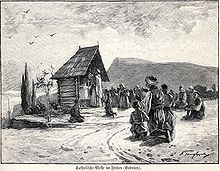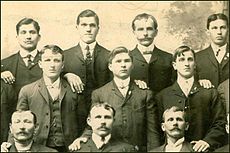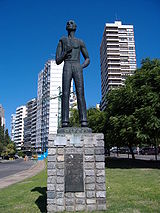- Croatian diaspora
-
Croatian diaspora refers to the Croatian communities that have formed outside Croatia. Estimates on its size are only approximate because of incomplete statistical records and naturalization, but (highest) estimates suggest that the Croatian diaspora numbers between a third[1] and a half[2] of the total number of Croats.
About four million Croats live in Croatia. The largest community outside of Croatia are the Croats of Bosnia and Herzegovina, one of the constitutive nations of that country, amounting to about 650,000.
The Croatian diaspora outside of Croatia and Bosnia and Herzegovina amounts to close to a million elsewhere in Europe, and to about 1.5 million overseas. The largest overseas community is reported from the United States, with about 450,000 members. In Western Europe, the largest group is found in Germany. The German census reports 228,000 Croats in Germany as of 2006, but estimates of the total number of people with direct Croatian ancestry (including naturalized German citizens) range as high as 450,000.
Contents
Croats of Bosnia and Herzegovina
Croats form one of the three constitutive nations in Bosnia and Herzegovina. They are frequently referred to as Bosnian Croats, but since the War in Bosnia and Herzegovina the number of Herzegovinian Croats exceeds the number in Bosnia. The Croats maintain an unofficial capital in Mostar, with the city being home to the largest Croatian population.
There is no precise data regarding Bosnia and Herzegovina's population since the last war. The UNHCR conducted an unofficial census in 1996, but the data has not been recognized. Ethnic cleansing within Bosnia and Herzegovina in the 1990s saw the vast majority of Croats move and take up residence in the Federation of Bosnia and Herzegovina. It is estimated that there are approximately 600,000 Croats in Bosnia and Herzegovina. According to 2000 data from the CIA World Factbook, Bosnia and Herzegovina is ethnically 14.3% Croat.[3]
Europe
- Balkans
 Serbia 70,602[4]
Serbia 70,602[4]  Slovenia 35,642 (2002)[5]
Slovenia 35,642 (2002)[5]  Montenegro 6,811 (2000)[6]
Montenegro 6,811 (2000)[6]  Romania 6,786[7]
Romania 6,786[7]- Western Europe
 Germany 227,510 (see Croatian German)[8]
Germany 227,510 (see Croatian German)[8]  Austria 150,719[9]
Austria 150,719[9]  Switzerland 40,484 (2006)[10]
Switzerland 40,484 (2006)[10]  France 30,000 (est)[11]
France 30,000 (est)[11] Hungary 25,730[12]
Hungary 25,730[12]  Italy 21,360[13]
Italy 21,360[13]  United Kingdom 6,992 (2001 UK Census)[14]
United Kingdom 6,992 (2001 UK Census)[14]- Scandinavia
 Sweden 6,063[15]
Sweden 6,063[15]  Denmark 5,400[16]
Denmark 5,400[16]  Norway 3,909[17]
Norway 3,909[17]Overseas
 United States 420,763 (2007)[18]
United States 420,763 (2007)[18]  Chile 380,000[8]
Chile 380,000[8]  Argentina 250,000[8]
Argentina 250,000[8] Australia 118,046 (2006)[19]
Australia 118,046 (2006)[19]  Canada 110,880[20]
Canada 110,880[20]  Peru 88,512 (see Croatian Peruvian)
Peru 88,512 (see Croatian Peruvian)  Bolivia 50,519
Bolivia 50,519  Brazil 45,000 (est)[8]
Brazil 45,000 (est)[8]  South Africa 8,000[21]
South Africa 8,000[21]United States
According to the 2005 US census, there are 401,208[22] Americans of full or partial Croatian descent.
In addition to that, many Croatian Americans identify themselves as Yugoslavs, Slavs, Dalmatians, Bosnians, Austrians, or Austro-Hungarians.
First Croatians in Detroit appeared around 1890, settling usually in the region of Russel. In Illinois the Croatians started concentrating mostly around Chicago. Although it was created a bit later, the Croatian settlement in Chicago became one of the most important ones in the United States.
The settlement especially started developing after World War I and Chicago became the center of all Croatian cultural and political activities. It is calculated that there were roughly 50,000 Croats in Chicago in the 1990s, while there were altogether 100,000 Croats living in 54 additional Croatian settlements in Illinois. There is a significant Croat population also in Indianapolis that settled during the Yugoslav Wars of the 90's.
Pittsburgh has always had a sizeable Croatian population. The headquarters of the Croatian Fraternal Union (CFU) - the oldest and largest Croatian organization in the United States - is located in the eastern suburb of Monroeville, PA. The CFU publishes a weekly newspaper "The Zajednicar Weekly" in both English and Croatian. Most of the Croatians in Pittsburgh originally settled in the early 1900s on the city's North Side. A neighborhood centered on East Ohio Street along the Allegheny River between Millvale and the North Shore was named Mala Jaska after an area in Croatia (northwest of Zagreb).
Canada
Chile
Croats are an important ethnic group in Chile; they are citizens of Chile who where either born in Europe or are Chileans of Croatian descent deriving their Croatian ethnicity from one or both parents. Chile has one of the largest communities of ethnic Croats outside the Balkans Peninsula and it is one of the most significant communities in the Croatian diaspora - second only to that which is found in the United States. They are one of the main example of successful assimilation of a non Spanish-speaking European ethnic group into Chilean society. Many successful entrepreneurs, scientists, artists and prominent politicians holding the highest offices in the country have been of Croatian descent.
The Croatian community first established itself in two provinces situated in the extreme ends of Chile: Antofagasta, in the Atacama desert of the north and Punta Arenas in the Patagonian region in the south. The massive arrival of Croats in Chile began in 1864 and the migration grew steadily until 1956 – reaching a number of more than 60,000.[23]
It is officially accepted that there are up to 380,000 Chileans of Croatian descent (who clearly identify themselves as Chilean-Croats).[8] Even though the number may be much higher with some demographic analysts estimating a figure of 750,000.[24]
Argentina
Main article: Croatian ArgentineArgentine of Croatian descent number over 450,000.[8]
The most successful of all the Croats in Argentina was also almost the first to arrive Nikola Mihanović came to Montevideo, Uruguay in 1867. Having settled in Buenos Aires, by 1909 Mihanović owned 350 vessels of one kind or another, including 82 steamers. By 1918, he employed 5,000 people, mostly from his native Dalmatia which was then under Austro-Hungarian and Italian rule. Mihanović by himself was thus a major factor in building up a Croat community which remains primarily Dalmatian to this day.
The second wave of Croat immigration was far more numerous, totalling 15,000 by 1939. Mostly peasants, these immigrants fanned out to work the land in Buenos Aires province, Santa Fe, Chaco, and Patagonia. This wave was accompanied by a numerous clergy to attend their spiritual needs, especially Franciscans.
If the first two waves had been primarily economic, the third wave after the Second World War was eminently political. Some 20,000 Croatian political refugees came to Argentina, and most became construction workers on Peron's public works projects until they started to pick up some Spanish.[25]
Australia and New Zealand
Croatia has been a source of migrants to Australia, particularly in the 1960s and 1970s. In 2006 118,051 persons resident in Australia (0.6%) identified themselves as having Croatian ancestor.
References
- ^ Hrvati u svijetu[dead link], Croatian Radio Television archive
- ^ Hrvatski Svjetski Kongres, Croatian World Congress, "4.5 million Croats and people of Croatian heritage live outside of the Republic of Croatia and Bosnia and Herzegovina", also quoted here
- ^ CIA World Factbook: Bosnia and Herzegovina 14.3% of a total population of 4,613,414 (July 2009 not including "Refugees and internally displaced persons" because they put Bosnian Croats together with other types.
- ^ 2002 Census in Serbia
- ^ Slovenian census 2002
- ^ Montenegrian census page 14 Population by national or ethnic affiliation - Review for Republic of Montenegro and municipalities
- ^ Census in Romania
- ^ a b c d e f Diaspora Croata
- ^ Census 2001 "Tabelle 5: Bevölkerung nach Umgangssprache und Staatsangehörigkeit", page 60 "131,307 Croatians + 19,412 Burgenland Croats = 150,719. In the Austrian census, Burgenland Croats are separate from the main Croat group."
- ^ 2006 Figures page 68, Petra-P12, gives a 40,484 number. as of 2004 page 12 2.1.1. Ständige ausländische Wohnbevölkerung nach Nationalität 2001 - 2004, gives a 44,035 number
- ^ La Croatie. Population et religions Embassy of Croatia in France "Diaspora. Plus de 2 millions de Croates (originaires de Croatie et de Bosnie-Herzégovine) vivent à l'étranger Dans la deuxième moitié du XIXe siècle de nombreux Croates ont émigré sur d'autres continents. Leurs descendants sont aujourd'hui 1,3 million aux États-Unis, 150 000 au Canada, 250 000 en Australie. Plus récemment, beaucoup sont partis vers l'Europe occidentale, principalement l'Allemagne où ils sont 280 000, l'Autriche 40 000, la Suisse 35 000, la France quelque 30 000."
- ^ Hungary census
- ^ Foreingers in Italy
- ^ "Country-of-birth database". Organisation for Economic Co-operation and Development. http://www.oecd.org/dataoecd/18/23/34792376.xls. Retrieved 2008-09-20.
- ^ By Ancestry 2008 "1.1.2 Population by country of birth 1900–2006" in page 6 says 6,063 and "1.1.3 Population by citizenship 1900–2006" in page 10 says 2,763
- ^ Denmark – People Groups
- ^ Statistics Norway - Persons with immigrant background by immigration category and country background. 1 January 2010
- ^ S0201. Selected Population Profile in the United States, Population Group: Croatian (109-110), Data Set: 2007 American Community Survey 1-Year Estimates, Survey: American Community Survey.
- ^ 2006 Census of Population and Housing. Australia "20680-Ancestry by Country of Birth of Parents - Australia"
- ^ Ethnic Origin (247), Single and Multiple Ethnic Origin Responses (3) and Sex (3) for the Population of Canada
- ^ Croatians in South Africa and their clubs
- ^ S0201. Selected Population Profile in the United States, Population Group: Croatian (109-110), Data Set: 2005 American Community Survey, Survey: American Community Survey
- ^ "Croacia y Chile: DUBROVNIK, EL ÚLTIMO BALUARTE". hrvatskimigracije.es.tl. 2008-04-10. http://hrvatskimigracije.es.tl/Croacia-y-Chile.htm?PHPSESSID=36d25ef77c698e5bfe8d0f7257c3e71c. Retrieved 2009-04-03.
- ^ hrvatski.
- ^ Croatian political refugees came to Argentina.
External links
- Croatian Heritage Foundation Hrvatska matica iseljenika (in Croat, English and Spanish)
- History of the Dalmatian community from Croatia in New Zealand
- Croatian Academic Union Germany Hrvatski akademski savez: Network of students and academics in Germany who are Croatians or of Croatian descent
Croatian diaspora Europe Americas Oceania Categories:- Croatian people
- Croatian diaspora
Wikimedia Foundation. 2010.



